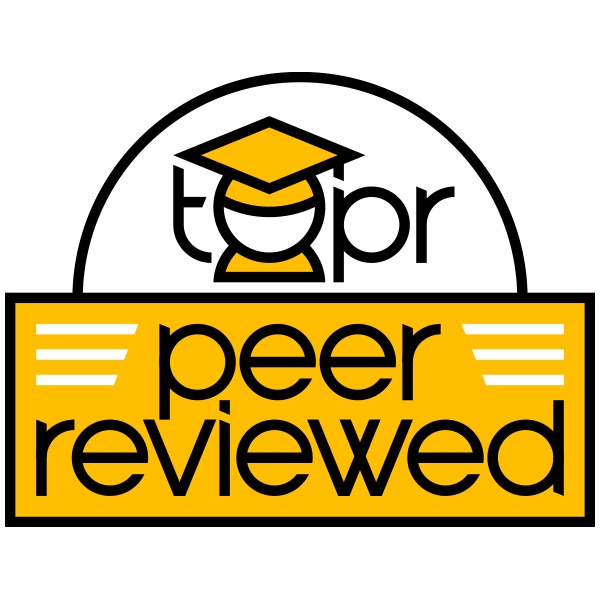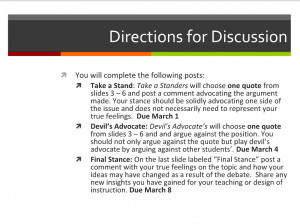
An online protocol called “Prompt a Stand” was used in conjunction with Voicethread, a tool for having online discussions, in order to foster a debate on a topic. Protocols are “strategies for having structured communication to enhance problem-solving, encourage different perspectives, and build shared knowledge (Dichter & Zydney, 2015). The Prompt a Stand protocol asks students to take on one of two roles: either an advocate or a devil’s advocate on an issue. The students pick one of 4 quotes posted in a Voicethread (see artifact) and write a post either solidly advocating or arguing against the quote. This initial post does not need to represent students true feelings on the topic. Later in the week, students make a final post explaining their true feelings on the topic and how their ideas may have changed as a result of the debate (See instructions). In a recent study, we found that protocols, similar to the one described above, prompted students to engage in more shared cognition and take greater ownership of the discussion (Zydney, deNoyelles, & Seo, 2012). Students expressed that the protocol helped them better understand what others were thinking. These protocols can be applied to a variety of different types of online discussions, and the Take a Stand protocol can be used for any topic that can be debated. From more details on a variety of online protocols, see Going Online with Protocols by McDonald, Zydney, Dichter, & McDonald (2012).
Link to example artifact(s)

Dr. Janet Mannheimer Zydney from the University of Cincinnati used Voicethread to facilitate online debate on the topic of the role that context should play in learning. The Prompt a Stand protocol asks students to take on one of two roles: either an advocate or a devil’s advocate on an issue. The students pick one of 4 quotes posted in a Voicethread (see artifact) and write a post either solidly advocating or arguing against the quote. This initial post does not need to represent students’ true feelings on the topic. Later in the week, students make a final post explaining their true feelings on the topic and how their ideas may have changed as a result of the debate (See instructions). For details on how to do the Prompt a Stand protocol discussion, please see the attached instructions and the link to the Voicethread.
Link to scholarly reference(s)
Dicther, A., & Zydney, J. M. (2015). Online protocols. In L.B. Easton (Ed.),, Powerful designs for professional learning (3rd ed.) (pp. 249 -261). Oxford, OH: Leaning Forward.
McDonald, J. P., Zydney, J. M., Dichter, A., & McDonald, B. (2012). Going online with protocols: New tools for teaching and learning. NY: Teachers College Press.
Zydney, J. M., deNoyelles, A., Seo, K. (2012). Creating a community of inquiry in online environments: An exploratory study on the effect of protocols on interactions within asynchronous discussions. Computers & Education, 58(1), 77-87.
Citation
Zydney, J. (2015). Using voicethread for online debate. In B. Chen & K. Thompson (Eds.), Teaching Online Pedagogical Repository. Orlando, FL: University of Central Florida Center for Distributed Learning. https://topr.online.ucf.edu/using-voicethread-for-online-debate/.